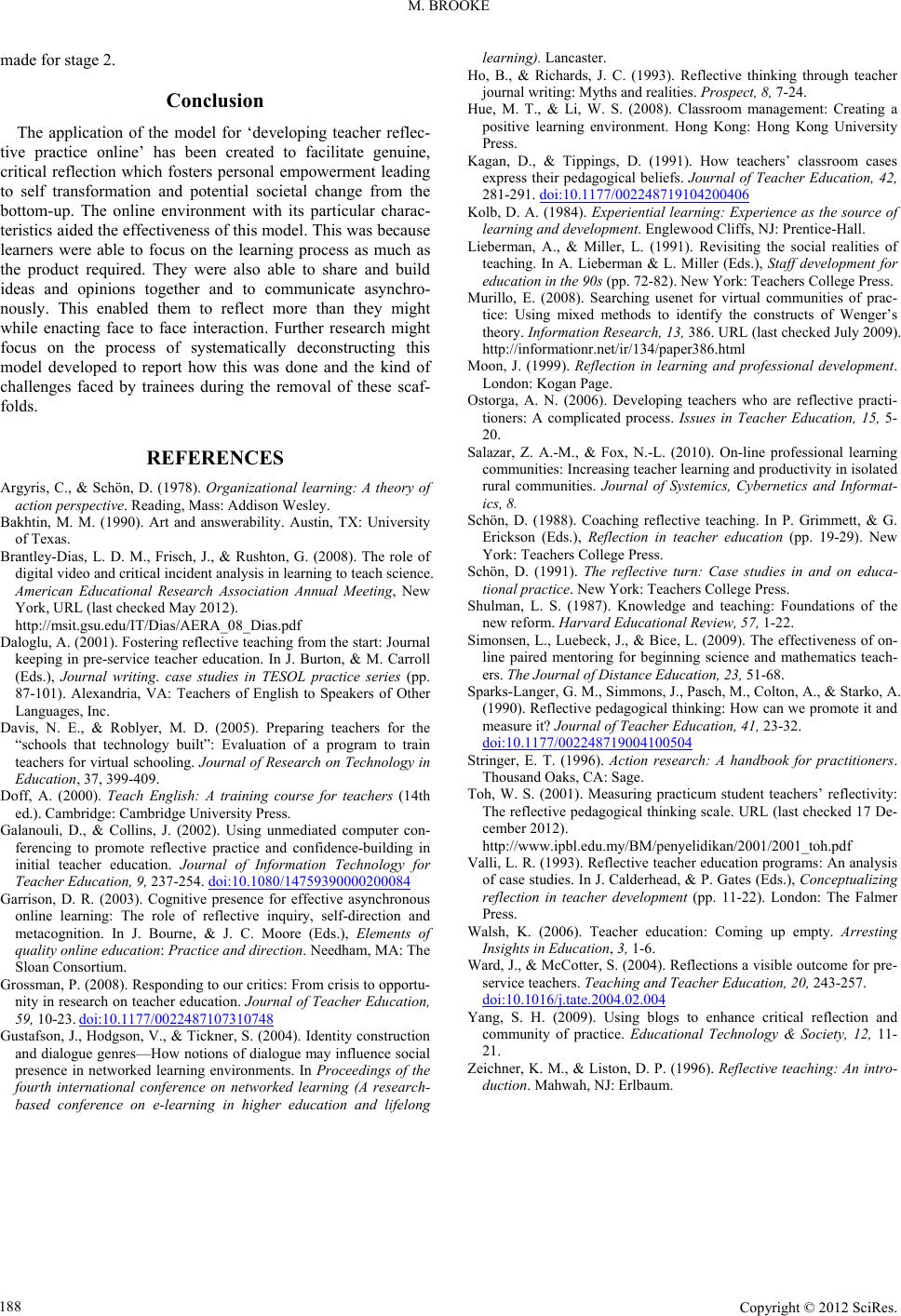
M. BROOKE
Copyright © 2012 SciRes.
188
made for stage 2.
Conclusion
The application of the model for ‘developing teacher reflec-
tive practice online’ has been created to facilitate genuine,
critical reflection which fosters personal empowerment leading
to self transformation and potential societal change from the
bottom-up. The online environment with its particular charac-
teristics aided the effectiveness of this model. This was because
learners were able to focus on the learning process as much as
the product required. They were also able to share and build
ideas and opinions together and to communicate asynchro-
nously. This enabled them to reflect more than they might
while enacting face to face interaction. Further research might
focus on the process of systematically deconstructing this
model developed to report how this was done and the kind of
challenges faced by trainees during the removal of these scaf-
folds.
REFERENCES
Argyris, C., & Schön, D. (1978). Organizational learning: A theory of
action perspective. Reading, Mass: Addison Wesley.
Bakhtin, M. M. (1990). Art and answerability. Austin, TX: University
of Texas.
Brantley-Dias, L. D. M., Frisch, J., & Rushton, G. (2008). The role of
digital video and critical incident analysis in learning to teach science.
American Educational Research Association Annual Meeting, New
York, URL (last checked May 2012).
http://msit.gsu.edu/IT/Dias/AERA_08_Dias.pdf
Daloglu, A. (2001). Fostering reflective teaching from the start: Journal
keeping in pre-service teacher education. In J. Burton, & M. Carroll
(Eds.), Journal writing. case studies in TESOL practice series (pp.
87-101). Alexandria, VA: Teachers of English to Speakers of Other
Languages, Inc.
Davis, N. E., & Roblyer, M. D. (2005). Preparing teachers for the
“schools that technology built”: Evaluation of a program to train
teachers for virtual schooling. Journal of Research on Technology in
Education, 37, 399-409.
Doff, A. (2000). Teach English: A training course for teachers (14th
ed.). Cambridge: Cambridge University P ress.
Galanouli, D., & Collins, J. (2002). Using unmediated computer con-
ferencing to promote reflective practice and confidence-building in
initial teacher education. Journal of Information Technology for
Teacher Education, 9, 237-254. doi:10.1080/14759390000200084
Garrison, D. R. (2003). Cognitive presence for effective asynchronous
online learning: The role of reflective inquiry, self-direction and
metacognition. In J. Bourne, & J. C. Moore (Eds.), Elements of
quality online education: Practice and direction. Needham, MA: The
Sloan Consortium.
Grossman, P. (2008). Responding to our critics: From crisis to opportu-
nity in research on teacher education. Journal of Teacher Education,
59, 10-23. doi:10.1177/0022487107310748
Gustafson, J., Hodgson, V., & Tickner, S. (2004). Identity construction
and dialogue genres—How notions of dialogue may influence social
presence in networked learning environments. In Proceedings of the
fourth international conference on networked learning (A research-
based conference on e-learning in higher education and lifelong
learning). Lancaster.
Ho, B., & Richards, J. C. (1993). Reflective thinking through teacher
journal writing: Myths and realities. Prospect, 8, 7-24.
Hue, M. T., & Li, W. S. (2008). Classroom management: Creating a
positive learning environment. Hong Kong: Hong Kong University
Press.
Kagan, D., & Tippings, D. (1991). How teachers’ classroom cases
express their pedagogical beliefs. Journal of Teacher Education, 42,
281-291. doi:10.1177/002248719104200406
Kolb, D. A. (1984). Experiential learning: Experience as the source of
learning and development. Englewood Cliff s, NJ: Prentice-Hall.
Lieberman, A., & Miller, L. (1991). Revisiting the social realities of
teaching. In A. Lieberman & L. Miller (Eds.), Staff development for
education in the 90s (pp. 72-82). New York: Teachers College Press.
Murillo, E. (2008). Searching usenet for virtual communities of prac-
tice: Using mixed methods to identify the constructs of Wenger’s
theory. Information Research, 13, 386. URL (last checked July 2009).
http://informationr.net/ir/134/paper386.html
Moon, J. (1999). Reflection in learning and professional development.
London: Kogan Page.
Ostorga, A. N. (2006). Developing teachers who are reflective practi-
tioners: A complicated process. Issues in Teacher Education, 15, 5-
20.
Salazar, Z. A.-M., & Fox, N.-L. (2010). On-line professional learning
communities: Increasing teacher learning and productivity in isolated
rural communities. Journal of Systemics, Cybernetics and Informat-
ics, 8.
Schön, D. (1988). Coaching reflective teaching. In P. Grimmett, & G.
Erickson (Eds.), Reflection in teacher education (pp. 19-29). New
York: Teachers College Press.
Schön, D. (1991). The reflective turn: Case studies in and on educa-
tional practice. New York: Teachers College Press.
Shulman, L. S. (1987). Knowledge and teaching: Foundations of the
new reform. Harvard Educational Review, 57, 1-22.
Simonsen, L., Luebeck, J., & Bice, L. (2009). The effectiveness of on-
line paired mentoring for beginning science and mathematics teach-
ers. The Journal of Distance Education, 23, 51-68.
Sparks-Langer, G. M., Simmons, J., Pasch, M., Colton, A., & Starko, A.
(1990). Reflective pedagogical thinking: How can we promote it and
measure it? Journal of Teacher Education, 41, 23-32.
doi:10.1177/002248719004100504
Stringer, E. T. (1996). Action research: A handbook for practitioners.
Thousand Oaks, CA: Sage.
Toh, W. S. (2001). Measuring practicum student teachers’ reflectivity:
The reflective pedagogical thinking scale. URL (last checked 17 De-
cember 2012).
http://www.ipbl.edu.my/BM/penyelidikan/2001/2001_toh.pdf
Valli, L. R. (1993). Reflective teacher education programs: An analysis
of case studies. In J. Calderhead, & P. Gates (Eds.), Conceptualizing
reflection in teacher development (pp. 11-22). London: The Falmer
Press.
Walsh, K. (2006). Teacher education: Coming up empty. Arresting
Insights in Education, 3, 1-6.
Ward, J., & McCotter, S. (2004). Reflections a visible outcome for pre-
service teachers. Teaching a nd Teacher Education, 20, 243-257.
doi:10.1016/j.tate.2004.02.004
Yang, S. H. (2009). Using blogs to enhance critical reflection and
community of practice. Educational Technology & Society, 12, 11-
21.
Zeichner, K. M., & Liston, D. P. (1996). Reflective teaching: An intro-
duction. Mahwah, NJ: Erlbaum.